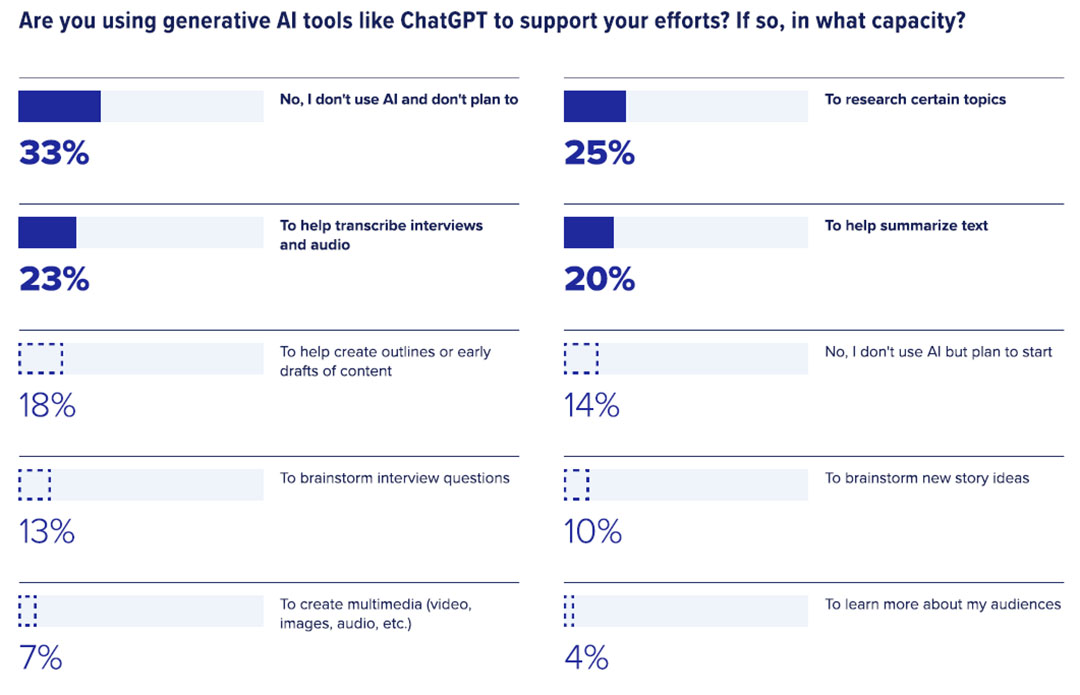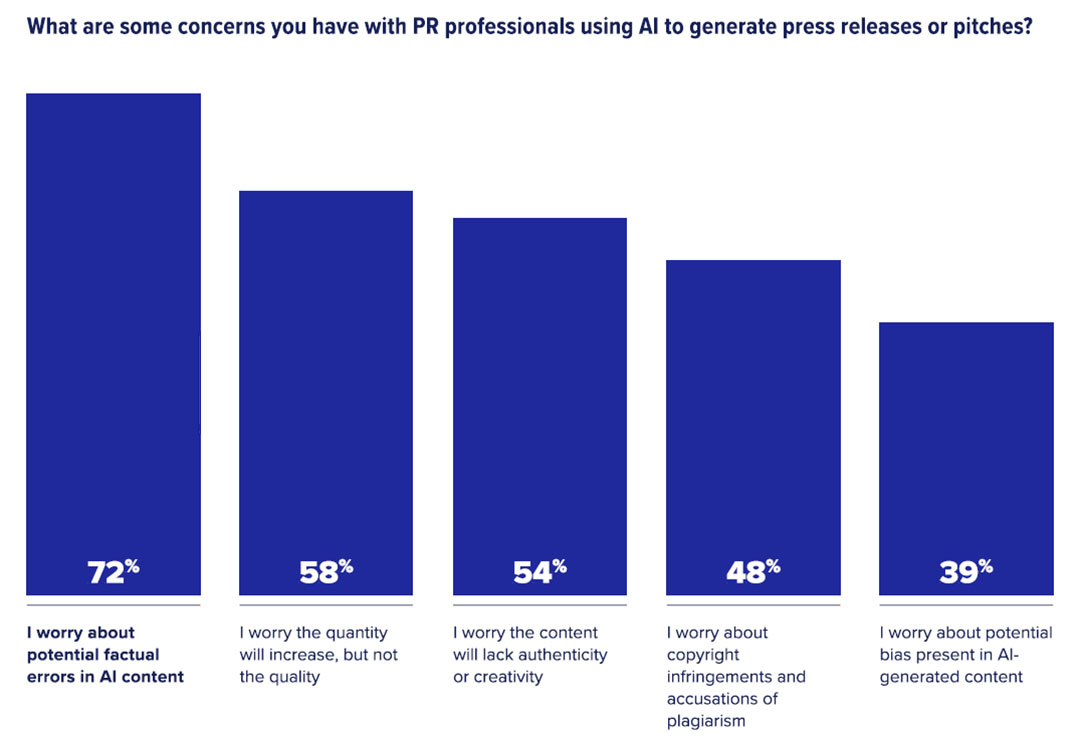Technology’s influence on journalism has been a significant if not always comfortable one. From the typewriter to the printing press, the internet and social media, reporters have always relied on tech innovation to create and share their stories, but the rising prominence of artificial intelligence (AI) has left many questions about how it will impact the profession.
AI has been working away in the background of journalism (and public relations) for some time. A spellcheck in Word? An audio transcription service? Using Grammarly or Hemingway Editor? They’re all powered by AI and have been useful tools for journalists; however, large language models (LLMs) that support generative AI like ChatGPT and Gemini are different. They can create content and copy from scratch, quickly and at scale, and naturally they’re being met with skepticism by editorial teams whose expertise lies in the written word.
Alongside the practical implications on how they work, today’s journalists play a key role in educating the public about AI and helping to shape its perception. They must also contend with the challenges of mis- and disinformation, areas where AI-generated content is only helping to amplify concerns.
In the 2025 State of the Media Report, 30% of journalists named the emergence of AI one of the biggest challenges the industry has faced in the last year (up from 26% in the 2024 report). It’s clearly a subject on the mind of reporters, so with our State of the Media surveying more than 3,000 reporters across the globe, we sifted through the data to get a sense of where they stand on the topic of AI usage in journalism (and public relations).
How Do Journalists Use AI?
Despite the industry’s reservations about the technology, journalists are leaning into generative AI to support their efforts, our findings show. Twenty-five percent are using it for research purposes, while 23% utilize it to help transcribe interviews and audio. A further 20% noted it helps them summarize text, and 18% use it create outlines or early drafts of content.
In total, 53% of journalists we surveyed said they use AI for their work in some form, and another 14% said they don’t use it but plan to start. A further 33% said they don’t use it and don’t plan to.

Our State of the Media survey also invited journalists to tell us other ways they use AI. Their answers ranged from help with drafting headlines to expressing their opposition to the technology. Here’s a selection of what they said:
AI in Journalism for Headline Writing
- “I use [AI] to help with titles (my weak spot).”
- “To think of catchy headlines.”
- “To create multiple headlines at pace.”
- “To brainstorm headings.”
AI in Journalism for SEO Optimization
- “I use it very sparingly for SEO and headline help.”
- “To generate keywords for web optimization.”
- “For hashtag ideas and SEO guidance.”
AI in Journalism for Data Processing and Analysis
- “I use AI to format data that needs to be entered into spreadsheets that would otherwise need to be done manually and take three times as long.”
- “I use AI to solve problems in Excel.”
- “Crunching structured data and large files such as financial reports and regulatory releases.”
Cautious or Anti-AI Usage
- "AI can be a useful starting point, but it is never complete or authoritative and should never be considered so.”
- “I've tried to use AI but it has been a waste of time. Bad research results. Wrong information. Just not worth it yet.”
- “I see it playing a role, but I will shun it for as long as I can. It's ghastly.”
- “AI is not allowed at my company.”
AI and Journalism: How Usage Differs by Region
In this year’s State of the Media Report, we were keen to look at regional variations in responses, so we split the data into North America, EMEA, and APAC segments. There were some stark differences in how journalists use AI across the globe.
North American journalists are most resistant, with nearly 1 in 2 (49%) saying they don’t use it and don’t plan to, compared to only 30% in EMEA and a mere 11% in APAC.
Research, transcription and summarization are the three most common ways in which journalists in EMEA and North America use AI; in APAC, generative AI is being used first to conduct outlines or early content drafts.
See the chart below for a region-by-region breakdown of generative AI use cases in journalism:

Journalists’ Views on AI in PR
As more PR and comms professionals leverage AI to help produce press releases and pitches, we wanted to understand how journalists felt about being on the receiving end of this content.
What the results surprisingly showed: The majority of journalists are open to the idea, with only 27% indicating they are “strongly opposed.” One quarter of journalists have no strong feelings either way. Most indicated that while they don’t prefer it, they would consider well-crafted AI-generated content from PR partners.
When it comes to their specific concerns about using AI in PR, factual errors top the list across all regions. Other serious concerns: Quantity of content will increase, but not necessarily quality, followed by loss of authenticity or creativity.

Regionally, there were some big variations in how journalists felt about PR professionals using AI to generate pitches or press releases.
Unsurprisingly, given that they are the group most strongly resistant to using it themselves, 2 in 5 journalists in North America indicated they’re strongly opposed. On the other end of the scale, journalists in APAC – the group with the highest usage rate themselves – are most in favor of PR professionals using AI.
Final Thoughts: 3 Key Takeaways for PRs
There’s no doubt that AI offers many opportunities for PR and communications teams, however, these findings underscore the need to be thoughtful and purposeful in using it, both in anything they create that’s public-facing and in how they communicate with journalists.
Here are three key takeaways for comms pros to keep in mind:
1. Be Transparent When Using AI in PR
Audiences value trust, authenticity, and accountability. Journalists understand this, too. In fact, in the 2025 State of the Media survey, 40% of reporters said maintaining credibility as a trusted news source was one of their biggest challenges. Making clear when AI has been used to create content should be front-of-mind for PR and comms professionals. Being open about the processes and tools used and establishing an AI code of ethics is a good first step and shows a commitment to transparency around AI research, development, and usage.
2. Use AI Carefully in Media Outreach
While AI can help create media outreach content like a pitch or press release, the technology is far from perfect. For one, AI-generated content can be easy to spot, and knowing journalists’ resistance to AI, any outreach they see that has been wholly created by it is unlikely to be well received.
Taking time to curate and humanize the AI-generated content is a must. AI has been shown to churn out inaccurate, if not completely false, information. So any time you use AI, it is critical you double-check and validate the output.
Bottom line: Even though AI can help with some PR tasks at scale, personalized (humanized), validated, and relevant press outreach remains critical to securing journalists’ attention and trust.
3. Take a Page Out of the Media’s Book
While many journalists are wary of generative AI tech, they are experimenting with a healthy level of skepticism, validating everything first. They know the technology isn't going away and is constantly evolving, but they also know it is still flawed in many ways and no replacement for human expertise.
To learn more about how CisionOne can help you navigate the challenges and opportunities of AI in PR, get in touch to speak with an expert today.
Most Recent Posts
Cision Resources
-
E-books and Guides
Comprehensive how-to guides on strategy and tactics
-
Case Studies
What are other brands doing – and how can we learn from them?
About Simon Reynolds
Simon is the Senior Content Marketing Manager at Cision. He worked as a journalist for more than a decade, writing on staff and freelance for Hearst, Dennis, Future and Autovia titles before joining Cision in 2022.
